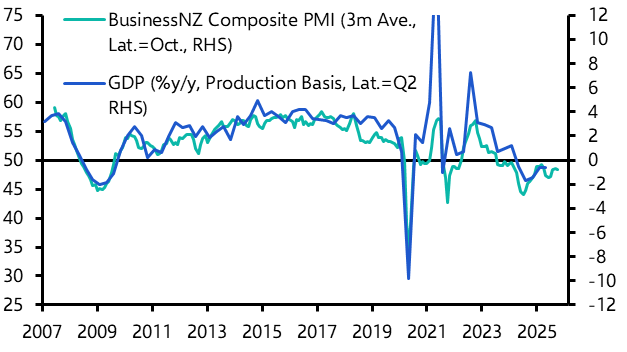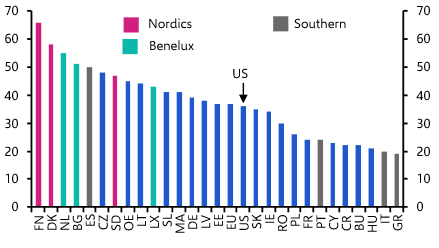Seemingly endless commentary has been devoted to the supposed death of globalisation. But as ever in economics, the story is not quite so simple.
The popular narrative goes like this: tariffs first introduced by Trump, maintained by Biden, and now turbo-charged in Trump’s second term, mark the rise of economic nationalism. Global integration is retreating; the free trading system of the post-Cold War is collapsing.
Yet the facts say otherwise. Global trade volumes remain near record highs. If this is deglobalisation, it’s a strangely open version.
The opposing view argues that globalisation is like gravity – an unstoppable force. Today’s tensions, by this logic, are temporary. But that view is too complacent. Globalisation has always come in waves, and those waves have broken before.
The real shift lies not in trade volumes, but in the political architecture underpinning them. The defining force now is the deepening US-China rivalry. While Trump’s 2016 election broke with the post-Cold War consensus, the true turning point came earlier: between the 2008 global financial crisis and Xi Jinping’s accession to the Chinese leadership in 2012.
Trump is a symptom rather than a cause of today’s tensions.
The crisis exposed globalisation’s failures. Xi, meanwhile, showed economic integration wouldn't necessarily lead to shared values. His priorities have been reasserting Party control at home and challenging US hegemony abroad. One consequence is that in both Washington and Beijing, economic policy is increasingly being viewed through a geopolitical lens. In this sense, Trump is a symptom rather than a cause of today’s tensions.
Fracturing ≠ deglobalisation
Rather than deglobalising, the world economy is splintering into competing blocs centred on the US and China. The economic implications will depend on how that fracturing unfolds – and how other countries align.
In a fractured world, trade flows will shift rather than shrink. Apple’s decision to move production to India, away from China, is just one example.
But this is about more than just trade. Beijing’s restrictions on rare earth exports show how strategic control over critical minerals is now a form of economic weaponry. Meanwhile, the Trump administration’s ‘America First’ investment agenda – with its explicit objective of attracting capital from allies while limiting flows from China – highlights how cross-border finance is increasingly subject to geopolitical interests.
So far, the focus has been on preserving supply chain security, national security and technological leadership. If this remains the case, then fracturing will have a profound effect on some parts of the global economy but much less on others. Products that contain high-tech components, such as the phones we use and the cars we drive, are highly exposed. The same is true of pharmaceutical products and “dual-use” goods that have both military and civilian applications. At the same time, however, it is possible that large parts of the global trading system that are not considered to be strategically important – from toys and games to white goods and furniture – could be unaffected.
Alliances matter
Another key question is how countries align. In a fractured world, friends matter. US efforts to restrict China’s access to advanced semiconductors have required cooperation from firms and governments in Japan, the Netherlands, Taiwan and South Korea.
Some believe that Europe could form a third pole in the global economy, alongside the US and China, around which other liberal democracies might coalesce. This is possible but unlikely. Europe is undoubtedly an important part of the global economy. Collectively, the European Union accounts for about 18 per cent of global GDP when measured at market exchange rates, similar to China’s share (17 per cent) but less than the US (27 per cent). The UK accounts for another 3 per cent of global GDP. Similarly, while Europe’s population is smaller than China’s, it is a little larger than the US. The EU is also the world’s second largest exporter as well as being its second largest import market.
But economic heft alone doesn’t make a superpower. Europe may be the only region with an economy to match the US and China, but it is still a collection of sovereign states that often struggles to speak with one voice. Moreover, Europe does not project its values onto others to the same extent as the US and China. Europe has followed, rather than led, the fracturing process, typically siding with the US (for example, in cutting Huawei out of its 5G infrastructure), but also mindful of its links to China. Europe tends to move slowly, seeking both consensus in decision-making and a middle-ground rooted in a rules-based global system. These are laudable qualities but they sit awkwardly against the new geopolitical reality and are reasons why a third bloc centred on Europe is a less likely outcome.
While most countries would prefer to remain neutral – and some will successfully straddle the two blocs – it will become increasingly difficult to do so over time. Most governments lack leverage. This constraint is seemingly reflected in recent US trade agreements with the UK and Vietnam, which were reported to include provisions designed to cut out Chinese suppliers in strategically important areas (in the case of the UK) and to limit Chinese rerouting of exports (in the case of Vietnam).
Similarly, a central feature of the recent US-EU trade deal, thrashed out at Trump’s golf course at Turnberry in late July, was a European commitment to buy around $750 billion in energy products from the US over three years, which would decrease it’s the EU’s reliance on Russian energy. Neutrality may be appealing, but the ability of other governments to act independently of the US or China is limited.
The US is starting from a position of strength. Its traditional allies include high-income knowledge economies (such as the UK), cutting-edge manufacturers (Taiwan, Korea, Japan, Germany), low-income manufacturers (Vietnam, Mexico) and major commodity producers like Canada and Australia. In contrast, China’s allies tend to fall into one of two camps: autocracies or commodity producers (and frequently both). This will give China an edge over the US in securing supplies of critical minerals, including those needed for the green transition. But it leaves the US with a broader, more adaptable base – and a potential edge in technology.
Trump’s aggressive use of tariffs, even against allies, could splinter the US-led bloc.
The real danger for Washington is that its aggressive stance – slapping tariffs on friends as well as foes – is pushing allies away and fracturing the US-led bloc. Treating partners as adversaries risks undermining the very unity the hawks in Washington need to counter China’s rise. If pursued in full, far from reinvigorating economic growth, the more extreme elements of Trump’s nationalist agenda could reduce US GDP growth to less than 1 per cent a year. In this case, “America First” would really mean “America Last”.
So where next? The path ahead will be shaped by three things: whether the US remains a leader around which the rest of the West coalesces; whether fracturing can be confined to strategic sectors; and whether intensifying rivalry edges closer to open conflict.
The idea of a cooperative, rules-based global order now looks increasingly out of step with reality. Power is starting to matter more than process. Trade policy is becoming an instrument of diplomacy rather than economics. For governments, this is uncomfortable. For businesses raised in a borderless world, it’s disorienting. But denying the shift is no longer an option. The challenge now is to adapt – and quickly.
Neil and other economists from the Capital Economics team will be presenting their latest analysis on how fracturing is proceeding in Trump’s second administration and the implications for global macro in a series of events this September and October.
Register to join the team in Singapore (3rd September), Hong Kong (4th September), London (17th September) or New York (9th October).




